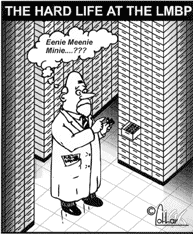
Edition 1/96
 Edition 1/96 |
Plasmids: the BCCM™'s Approach |
 BCCM™ News: Professor Remaut, what are plasmids? Where are they found in nature?
BCCM™ News: Professor Remaut, what are plasmids? Where are they found in nature?
ER: Plasmids are circular, double-stranded DNA molecules capable of autonomous replication within living cells. They are not, in general, an integrated part of the main genome, although some may insert themselves into the host DNA.
Plasmids have been identified in virtually all species of prokaryotes and also in some fungal strains. Although not essential for the survival of their host, they may encode a wide variety of genetic determinants that increase survival in adverse environmental conditions or that bestow a competitive advantage over other micro-organisms occupying the same ecological niche.
With the recent outbreak of bacterial infections (see feature article, this issue), the so-called ‘R-factor’ plasmids offer a timely example of such behaviour. These plasmids specify resistance to many antibiotic agents and are frequently responsible for generalized antibiotic resistance in clinical isolates. Fortunately, there are also examples of a more positive nature: the ability of certain bacterial species to degrade spilt oil is encoded by resident plasmids, for instance.
Is there a feature that distinguishes plasmids from the other biological resources held in the BCCM™’s collections?
ER: Plasmids are unique in that they may be isolated from their host and stored as naked DNA. This feature is a bonus to the curator as it provides a means of storing genetic information in a virtually inert form, free from mutational risks. Moreover, through the application of genetic engineering techniques it is now possible to insert essentially any genetic character, derived from any organism, into a naturally occurring plasmid and clone the ‘construct’ in a chosen bacterial host. To give just one of many exciting examples, lactococci - normally used in the dairy and food sector - are now being turned to the production of vaccines and cytokines.
What should be the main task of a plasmid collection?
ER: In my opinion, the foremost mission of a plasmid collection is to safeguard the rapidly increasing number of plasmids - both isolated from naturally occurring strains and man-made. Hence the importance of an established reference collection dedicated to assuring plasmid authenticity and to providing an efficient and reliable service. This is one of the objectives of the BCCM™/LMBP’s Total Quality Management programme.
What, in your opinion, are the strengths of the BCCM™/LMBP collection?
ER: First, the quality of information that we provide. Most of the plasmids stored at the BCCM™/LMBP are described in the highest available molecular detail, including functional features such as cloned genes, promoters, transcriptional and translational control elements. We also hold information on the construction of each plasmid, its application areas, required host strains, selection markers, restriction sites map and many more valuable details.
Second, the efficient provision of this information. We have established a database of biological and structural plasmid data that makes it easy to search for the most appropriate plasmid for any given application that a client is looking for. What is more, this database will be made available on the Internet, making world-wide access a reality.
What areas of the BCCM™/LMBP’s work do you intend to strengthen?
ER: We will continue to broaden our range of natural plasmids and will include more recombinant constructs that are operational in a wider variety of bacterial species, such as lactic acid bacteria and psychrophiles. At the same time, we intend to maintain our long-standing policy of obtaining the material from the original source - a prerequisite for a good value collection - and should like to invite readers to inform us of their constructs with a view to their eventual public or patent deposit.
Contact: Prof. E. Remaut, BCCM™/LMBP
E-mail: erik.remaut@lmb1.rug.ac.be
Tel: +32 9 264 53 47
Fax: +32 9 264 53 48
 BCCM BCCMHome |
Contents Edition 1/96 | Next Article Edition 1/96 |